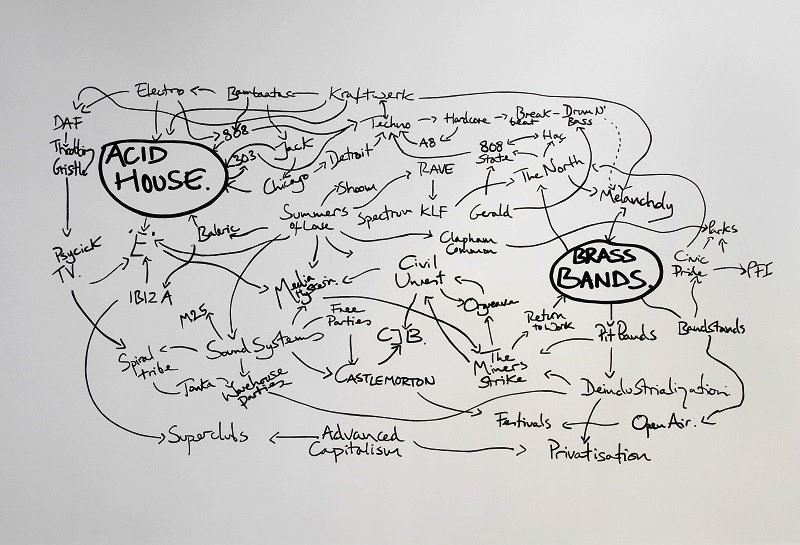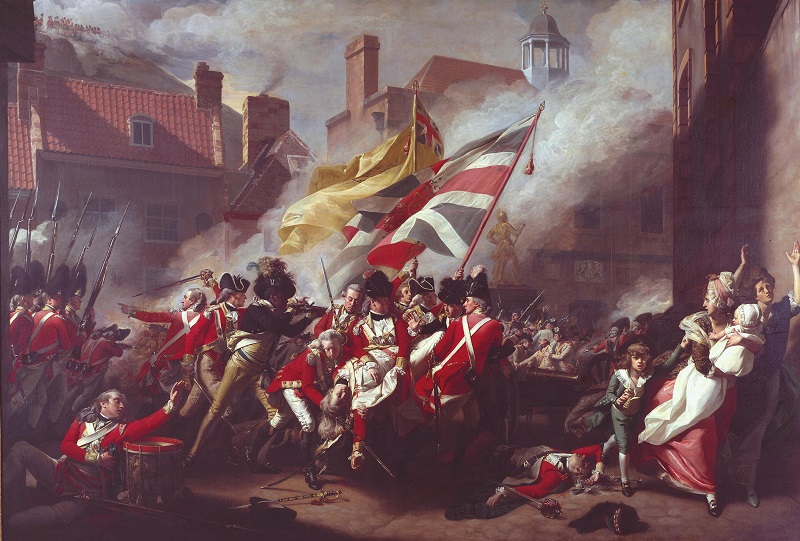Fighting History, Tate Britain | reviews, news & interviews
Fighting History, Tate Britain
Fighting History, Tate Britain
A desperate effort to prove that history painting is alive and well only saps what life is left

For all the wrong reasons, the work of Dexter Dalwood serves as a useful metaphor for this exhibition. Trite, tokenistic and desperate to look clever, Dalwood’s paintings are as tiresomely inward-looking as the show itself, which is a dismal example of curatorial self-indulgence at the expense of public engagement.
There’s nothing sound about this exhibition though, and its dubious thesis, insofar as there is one, is that history painting is not half as boring as we might think. The first room seems to push the genre to arm’s length, hoping perhaps to reassure us that it is not all about overblown narrative, and that some of it is actually rather radical and right on. Dominated by Dalwood’s The Poll Tax Riots, 2005 (main picture), and Jeremy Deller’s The History of the World, 1997-2004 (pictured below), the room is meant to confound our preconceptions but instead only draws attention to the show's second, equally fatuous, line of argument.
 Jeremy Deller’s word map is not a history painting. It connects traditional brass band music to acid house, exploring the nature of history by suggesting the connections and points of confluence between these two apparently irreconcilable types of music. But its inclusion at the beginning of the show signals a surprising, and surely unjustifiable broadening of the definition of history painting to include anything that tackles a historical subject.
Jeremy Deller’s word map is not a history painting. It connects traditional brass band music to acid house, exploring the nature of history by suggesting the connections and points of confluence between these two apparently irreconcilable types of music. But its inclusion at the beginning of the show signals a surprising, and surely unjustifiable broadening of the definition of history painting to include anything that tackles a historical subject.
Propping up this bizarre decision is an unnecessary bit of quibbling over the definition of history painting, a genre that is surely quite easy to define. Didactic and preoccupied with grand narrative, showcasing the accomplishment and learning of the artist, it expounds themes from classical history or the Bible or immortalises pivotal, historically significant moments from the more recent past (Pictured below: John Singleton Copley, The Death of Major Peirson, 6 January 1781, 1783). History is used in the French, or Italian sense to mean narrative: what it is not about is the simple depiction of historical events. Clear this may be, but talking up a controversy over nomenclature conveniently allows the show to develop its pet theory, which is that baggily defined, history painting has flourished unabated since the 18th century.
Having dispensed with any meaningful parameters, all sorts of unlikely paintings become fair game, including Lawrence Alma-Tadema’s The Silent Greeting, 1889, pure sugary sentiment, in which a Roman soldier is seen leaving a bouquet of flowers on his sleeping lover’s lap. There’s no grand narrative here, and The Room in Which Shakespeare was Born, by Henry Wallis, 1853, however laden with meaning, is surely equally miscast as history painting.
 Curiously enough, while plenty of unsuitable pictures are marshalled under the banner of history painting, perfectly usable examples of artists repurposing the genre have been overlooked. Ford Madox Brown’s Work, 1865, is not a history painting, but its large scale, and multiple representations of the body in a range of poses, exploit contemporary viewers’ knowledge and expectations of history painting in order to elevate and dignify its lowly and unconventional subject matter, the working man.
Curiously enough, while plenty of unsuitable pictures are marshalled under the banner of history painting, perfectly usable examples of artists repurposing the genre have been overlooked. Ford Madox Brown’s Work, 1865, is not a history painting, but its large scale, and multiple representations of the body in a range of poses, exploit contemporary viewers’ knowledge and expectations of history painting in order to elevate and dignify its lowly and unconventional subject matter, the working man.
There is a brief but essential diversion to acknowledge the influence of history painting on portraiture, but Turner – a figure famously well-represented in the Tate’s own collections – is barely here at all. And yet he not only produced any number of history paintings, he transformed landscape painting, elevating it to the status of history painting by imbuing it with gravitas and showing that it was capable of handling the most profound and edifying of themes.
Having failed to examine the ways in which the conventions of history painting were appropriated by other genres, the curators have sabotaged the climax to the show, which is Jeremy Deller’s The Battle of Orgreave Archive, 2001, a work which exists today as a collection of film and archive material documenting the epic re-enactment of this most notorious episode of the Miners’ Strike.
It just doesn’t sit well within this strange hotchpotch of paintings, and as such it is unconvincing as evidence of history painting, alive and well but reconfigured for the 21st century. In fact if this exhibition proves anything, it is that history painting is well and truly finished – Dexter Dalwood’s empty, contrived attempts to revisit the genre are ample proof of that.
Explore topics
Share this article
The future of Arts Journalism
You can stop theartsdesk.com closing!
We urgently need financing to survive. Our fundraising drive has thus far raised £33,000 but we need to reach £100,000 or we will be forced to close. Please contribute here: https://gofund.me/c3f6033d
And if you can forward this information to anyone who might assist, we’d be grateful.

Subscribe to theartsdesk.com
Thank you for continuing to read our work on theartsdesk.com. For unlimited access to every article in its entirety, including our archive of more than 15,000 pieces, we're asking for £5 per month or £40 per year. We feel it's a very good deal, and hope you do too.
To take a subscription now simply click here.
And if you're looking for that extra gift for a friend or family member, why not treat them to a theartsdesk.com gift subscription?
more Visual arts
 Help to give theartsdesk a future!
Support our GoFundMe appeal
Help to give theartsdesk a future!
Support our GoFundMe appeal
 Ed Atkins, Tate Britain review - hiding behind computer generated doppelgängers
Emotions too raw to explore
Ed Atkins, Tate Britain review - hiding behind computer generated doppelgängers
Emotions too raw to explore
 Echoes: Stone Circles, Community and Heritage, Stonehenge Visitor Centre review - young photographers explore ancient resonances
The ancient monument opens its first exhibition of new photography
Echoes: Stone Circles, Community and Heritage, Stonehenge Visitor Centre review - young photographers explore ancient resonances
The ancient monument opens its first exhibition of new photography
 Hylozoic/Desires: Salt Cosmologies, Somerset House and The Hedge of Halomancy, Tate Britain review - the power of white powder
A strong message diluted by space and time
Hylozoic/Desires: Salt Cosmologies, Somerset House and The Hedge of Halomancy, Tate Britain review - the power of white powder
A strong message diluted by space and time
 Mickalene Thomas, All About Love, Hayward Gallery review - all that glitters
The shock of the glue: rhinestones to the ready
Mickalene Thomas, All About Love, Hayward Gallery review - all that glitters
The shock of the glue: rhinestones to the ready
 Interview: Polar photographer Sebastian Copeland talks about the dramatic changes in the Arctic
An ominous shift has come with dark patches appearing on the Greenland ice sheet
Interview: Polar photographer Sebastian Copeland talks about the dramatic changes in the Arctic
An ominous shift has come with dark patches appearing on the Greenland ice sheet
 Donald Rodney: Visceral Canker, Whitechapel Gallery review - absence made powerfully present
Illness as a drive to creativity
Donald Rodney: Visceral Canker, Whitechapel Gallery review - absence made powerfully present
Illness as a drive to creativity
 Noah Davis, Barbican review - the ordinary made strangely compelling
A voice from the margins
Noah Davis, Barbican review - the ordinary made strangely compelling
A voice from the margins
 Best of 2024: Visual Arts
A great year for women artists
Best of 2024: Visual Arts
A great year for women artists
 Electric Dreams: Art and Technology Before the Internet, Tate Modern review - an exhaustive and exhausting show
Flashing lights, beeps and buzzes are diverting, but quickly pall
Electric Dreams: Art and Technology Before the Internet, Tate Modern review - an exhaustive and exhausting show
Flashing lights, beeps and buzzes are diverting, but quickly pall
 ARK: United States V by Laurie Anderson, Aviva Studios, Manchester review - a vessel for the thoughts and imaginings of a lifetime
Despite anticipating disaster, this mesmerising voyage is full of hope
ARK: United States V by Laurie Anderson, Aviva Studios, Manchester review - a vessel for the thoughts and imaginings of a lifetime
Despite anticipating disaster, this mesmerising voyage is full of hope

Add comment